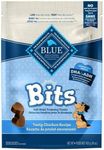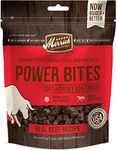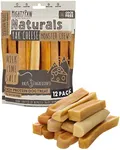Buying Guide for the Best Training Treats For Puppies
Choosing the right training treats for your puppy is an important step in making training sessions effective and enjoyable. The right treats can motivate your puppy, reinforce good behavior, and help build a strong bond between you and your pet. When picking training treats, it's important to consider factors that affect your puppy's health, attention span, and overall training experience. Understanding the key specifications will help you select treats that are both safe and appealing for your puppy.Size of TreatThe size of the treat refers to how big each individual piece is. This is important because training often involves giving multiple treats in a short period, so you want something small enough that your puppy can eat quickly without getting full or distracted. Treats generally come in tiny, small, and medium sizes. Tiny treats are best for frequent rewards and small breeds, while medium treats might be better for larger puppies or less frequent rewards. Choose a size that your puppy can eat in one bite, so training stays fast-paced and fun.
TextureTexture describes whether the treat is soft, chewy, or crunchy. Soft and chewy treats are usually preferred for training because they are easy to break into smaller pieces and are quickly eaten, keeping your puppy focused on you. Crunchy treats can take longer to eat and may distract your puppy during training. If your puppy is teething or has sensitive teeth, softer treats are a better choice. Consider your puppy’s chewing ability and the speed of your training sessions when picking the texture.
IngredientsIngredients are what the treat is made from, and this is crucial for your puppy’s health. Look for treats with simple, natural ingredients and avoid those with artificial colors, flavors, or preservatives. Some treats are made with single proteins (like chicken or salmon), which are good for puppies with sensitive stomachs or allergies. If your puppy has any dietary restrictions, always check the ingredient list. Choose treats that align with your puppy’s nutritional needs and any advice from your veterinarian.
Calorie ContentCalorie content tells you how many calories are in each treat. This matters because puppies have small stomachs and can easily gain weight if given too many high-calorie treats. Treats with lower calories per piece are better for frequent training sessions, as you can reward your puppy often without overfeeding. If you train a lot, look for treats with fewer calories to help maintain a healthy weight for your puppy.
PalatabilityPalatability means how tasty and appealing the treat is to your puppy. Highly palatable treats are more motivating and can make training more effective, especially when teaching new or difficult commands. Some puppies are pickier than others, so you may need to try a few different flavors or types to see what your puppy likes best. Choose treats that your puppy gets excited about, as this will keep them engaged and eager to learn.



















